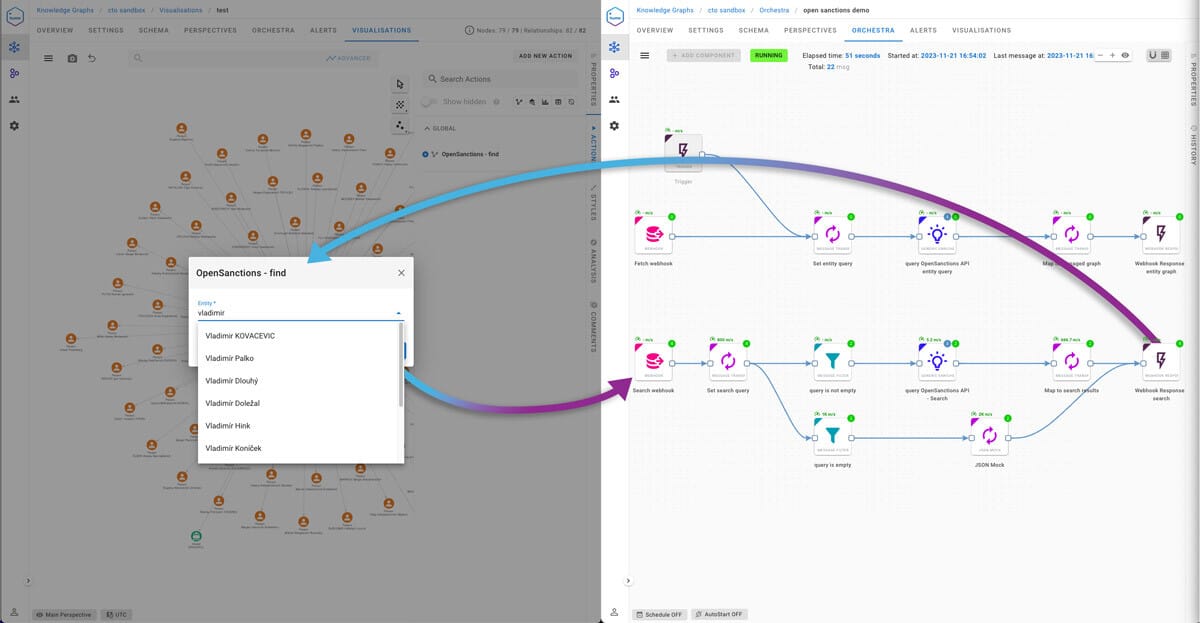New HTTP API Actions available directly in the visualisation interface
Hume 2.21 introduces the revolutionary ability to connect Orchestra Workflows to HTTP API Actions — allowing data analysts to access external data sources on demand, directly in the visualisation interface, simply by running custom actions.
By connecting with external systems via Orchestra Workflows, Hume liberates developers from the constraints of custom middleware, ensuring rapid, cost-effective, and unrestricted access to diverse data sources. The significance lies in its ability to seamlessly connect with a diverse array of external systems.
Reflecting on this innovation, Miro Marchi – Head of Product for Hume – said: “While a custom-coded middleware offers limitless possibilities, it has higher cost and time to production. At GraphAware, we’re ready to assist customers with such integrations whenever needed. However, we’ve found that the majority of use cases can be efficiently addressed with low-code workflows in Orchestra, where developers can focus immediately on their custom integration process, dramatically accelerating time to value”
Data processed by Orchestra can be sent directly to the visualisation in different forms – as graphs, tables, or charts – to be consumed by analysts on-the-fly during their investigations.
The following types of data sources are now easily accessible directly from analyst view:
- Massive databases: Enormous transactional databases that can’t be fully ingested due to their sheer volume
- Regulated data: Sensitive sources like wiretapped phones, regulated by law, that can only be accessed on-demand, not stored entirely within the graph
- Data pollution Prevention: External open-source databases, such as social media, that required ingestion based on specific queries to prevent data pollution
- Limited interfaces: Some legacy systems that lack interfaces other than HTTP APIs for queries, making traditional data ingestion methods impossible

Cost and time effective compared to middleware
The low-code editor for Orchestra workflows simplifies development, while automated deployment, error management, and built-in security ensure flawless operations. Instant one-click controls and swift iterations boost efficiency, making data workflows not just effective, but also easily manageable for technical professionals. Workflows can connect to any external system via HTTP calls or using the built-in connectors for some of the most popular SQL and NoSQL databases, message brokers, and file systems — and on top of that can handle data transformations, enrichments, and complex business logic orchestration. Hume’s HTTP API Actions combined with Orchestra workflows empower users to effortlessly bridge gaps between different systems, enabling efficient data processing tailored to their specific needs.


For our customers, seamless integration with external systems is paramount. The introduction of HTTP Actions represents a pivotal advancement, providing data analysts the opportunity to access mission-critical data such as social networks or other external providers. This innovation empowers them to craft tailored integrations, addressing the specific needs of their analysts.
For example, massive transactional databases, due to their sheer volume, cannot be fully integrated into the graph. Additionally, data from sources like wiretapped phones, governed by strict regulations, can only be accessed on-demand, not stored entirely within the graph. Moreover, external open-source databases, such as social media platforms or biometric databases, are best ingested based on specific queries on the fly to prevent data pollution and guarantee security and compliance with legal restrictions in handling this data.
